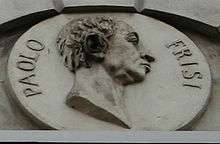Paolo Frisi
Paolo Frisi (13 April 1728 – 22 November 1784) was an Italian mathematician and astronomer.[1]
Paolo Frisi | |
|---|---|
 Paolo Frisi | |
| Born | 13 April 1728 Melegnano, Italy |
| Died | 22 November 1784 (aged 56) Milan, Italy |
| Nationality | Italian |
| Scientific career | |
| Fields | Astronomy |
Biography

Frisi was born in Melegnano in 1728; his sibling Antonio Francesco, born in 1735, went on to be a historian.[2] Frisi was educated at the local Barnabite monastery and afterwards in that of Padua. When twenty-one years of age he composed a treatise on the figure of the earth, and the reputation which he soon acquired led to his appointment by the King of Sardinia to the professorship of philosophy in the College of Casale. His friendship with Radicati, a man of liberal opinions, occasioned Frisis removal by his clerical superiors to Novara, where he was compelled to do duty as a preacher.[1]
In 1753 he was elected a corresponding member of the Paris Academy of Sciences, and shortly afterwards he became professor of philosophy in the Barnabite College of St Alexander at Milan. An acrimonious attack by a young Jesuit, about this time, upon his dissertation on the figure of the earth laid the foundation of his animosity against the Jesuits, with whose enemies, including Jean d'Alembert, J. A. N. Condorcet and other Encyclopedists, he later closely associated himself. In 1756 he was appointed by Leopold, Grand Duke of Tuscany, to the professorship of mathematics in the university of Pisa, a post which he held for eight years. In 1756[3] he became an associate of the Imperial Academy of St Petersburg, and a foreign member of the Royal Society of London, and in 1758 a member of the Academy of Berlin, in 1766 of that of Stockholm, and in 1770 of the Academies of Copenhagen and of Bern. From several European crowned heads he received, at various times, marks of special distinction, and the empress Maria Theresa granted him a yearly pension of 100 sequins.[1]
In 1764 he was created professor of mathematics in the palatine schools at Milan, and obtained from Pope Pius VI the release from ecclesiastical jurisdiction, and authority to become a secular priest. In 1766 he visited France and England, and in 1768 Vienna. His knowledge of hydraulics caused him to be frequently consulted with respect to the management of canals and other watercourses in various parts of Europe. It was through his means that lightning conductors were first introduced into Italy for the protection of buildings.[1]
In 1766, Frisi was elected a foreign member of the Royal Swedish Academy of Sciences.
He died in Milan in 1784. There is a street named after him in Melegnano[4] and a high school in Monza.[5]
Works
- De motu diurno terrae. Pisis: ex nova Typographia Io. Paulli Giovannelli & sociorum. 1756.
- De gravitate universali corporum. Mediolani: apud Joseph Galeatium regium typographum. 1768.
- Del modo di regolare i fiumi, e i torrenti, principalmente del bolognese, e della Romagna. In Lucca: per Vincenzo Giuntini, a spese di Giovanni Riccomini. 1762.
- Instituzioni di meccanica, d'idrostatica, d'idrometria e dell'architettura statica e idraulica. In Milano: appresso Giuseppe Galeazzi Regio Stampatore. 1777.
- Piano de' lavori da farsi per liberare, e assicurare dalle acque le provincie di Bologna, di Ferrara, e di Ravenna. In Lucca: per Vincenzo Giuntini, a spese di Giovanni Riccomini. 1761.
- Elogio del cavaliere Isacco Newton. 1778.
- Elogio del signor D'Alembert. In Milano: appresso Giuseppe Galeazzi regio stampatore. 1786.
- De' canali navigabili trattato del P. D. Paolo Frisi. In Firenze: nella Stamperia Granducale per Gaetano Cambiagi. 1770.
- Algebra e geometrica analitica (1782)
- Meccanica (1783)
- Cosmographiae physicae et mathematicae (1774-1775)
- Saggio della morale filosofica
- Elogio di Galileo Galilei e di Bonaventura Cavalieri
See also
- List of Roman Catholic scientist-clerics
References
-

- Antinio Frisi, Cassiciaco.it, Retrieved 27 August 2015
- Фризи Паоло, аббат // Russian Academy of Sciences
- Via Frisi di Melegnano
- Liceo Paolo Frisi di Monza